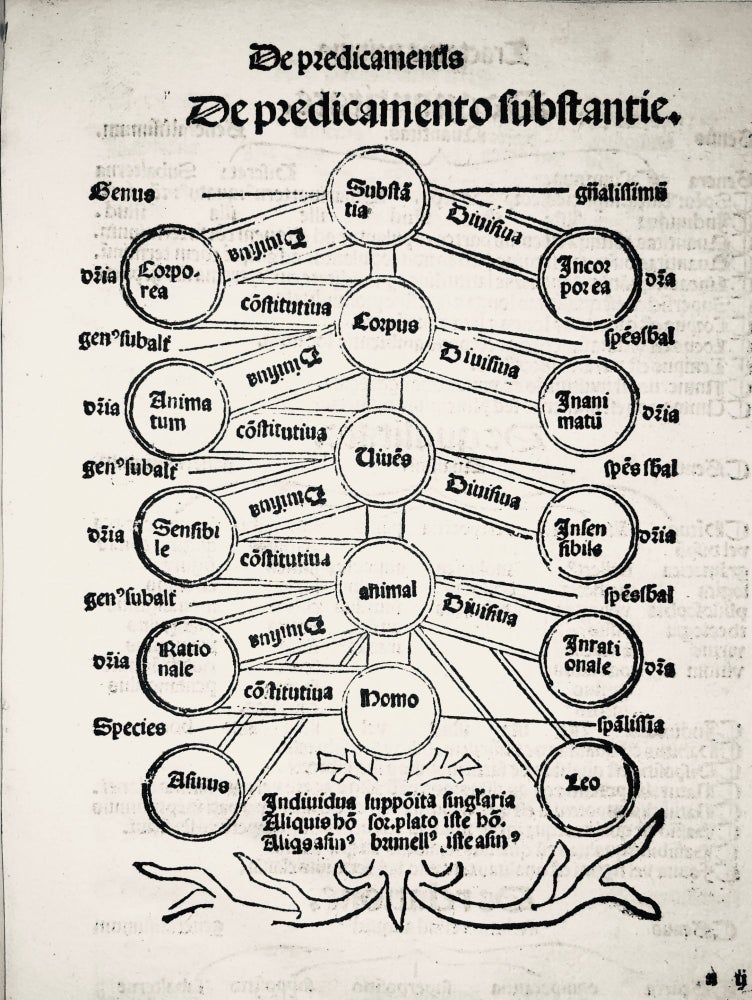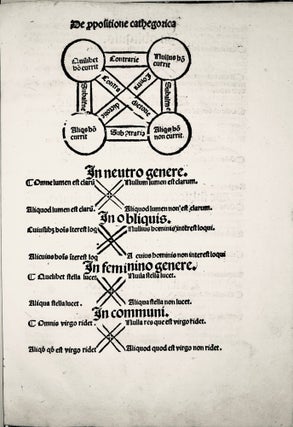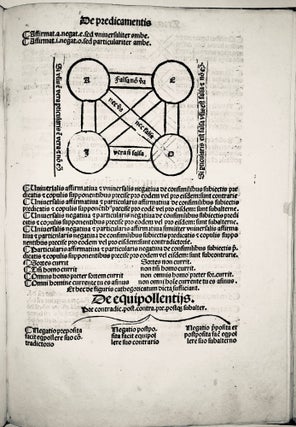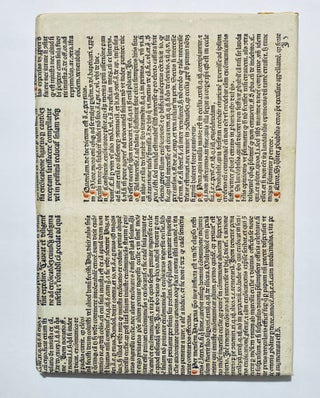Logica magistri Pauli Pergulensis.
Venice : Johannes Emericus, de Spira, 22 Feb. 1495/96, ca -1455. Signature of Thomas Stewart, Knight of St. John of Jerusalem, dated Rome 1837 on title.bound in an incunable leaf over boards. Light dampstaining in lower margins throughout, title and last page soiled. Italy, the centre of humanism, produced the best logicians of the Renaissance. Paulus Pergulensis (d. 1451) was a pupil of Paul of Venice, author of the Logica magna and parva.. Introducing the theory of reference, sometimes called supposition, is an explanation of the ways in which words refer to objects in function of certain linguisitc signs.
Paul of Venice maintains a threefold division: Material Reference, Simple Reference, and Personal Reference, all of which are identified The present is a more succinct and highly systematized logic, composed entirely in the form of theses.
From 1420 to 1454 Pergulensis taught logic and natural philosophy, and then also mathematics, astronomy and theology, to the Venetian school of Rialto (founded in 1408 ), to which he gave a real university organization. He was nominated (1448 ) bishop of Koper, which he renounced so as not to leave the teaching. We are left of him, manuscripts or press, some treatises of logic (Dubia in consequentias Strodi, De sensu composite and divided, In regulas insolubilium , De scire et dubitare , Compendium logicae ), in which he discusses the new logical doctrines of the Oxford school in Padua by Paolo Veneto.
Paul of Pergula (died 1451) became the first publicly paid lecturer in philosophy in Venice, where he was officially honored in a public ceremony. In 1448, he was offered a bishopric, which he refused, and at the end of his life he accepted the administration of the Church of Saint John Almoner. He translated some works of Aristotle from Greek to Latin and was considered “on a par with the renowned Greek and Latin philosophers” (Brown, pp. vi-vii). Depending on the Logica Parva of Paul of Venice, De sensu composito et diviso should be regarded as a “mosaic of the treasury of logic known at the time” (Brown, p. viii).
Lohr, C.H. “A Note on Manuscripts of Paulus Venetus, Logica,” Manuscripta, 17(1973), pp. 35-36; reprinted in Bulletin de philosophie medievale, 15 (1973), pp. 145-146.
The first edition was printed in Pavia, Martinus de Lavalle, 5 November 1488 (Goff P-198).
Perreiah, Alan. Paul of Venice: Logica Parva [English translation], Munich, Philosophia Verlag, 1984. Item #145J
All editions are rare:
P190 1481 Ratdolt 2 us Pml ,HeHl
P191. 1483 Tortis 2 us Hehl, JHU
P192. 1486 Tortis 2 us UPaL, (EHLS Rockport maine)
P193. 1489 Tridinesis 1 us LOC
P194. 1491 deStrada 1 us WartG
P195 1495 Emericus , 3 us NewL, PrinUL, and this copy
P196. 1489 Quarengiia 3 us LC, UILL, YUL
Paulus Pergulensis ca -1451. Ennio De Bellis, Nicoletto Vernia e Agostino Nifo: aspetti storiografici e metodologici, Congedo, 2003, p. 9.
Logica; and, Tractatus de sensu composito et diviso by Paolo della Pergola, edited by Mary Anthony Brown, Saint Bonaventure, New York: Franciscan Institute, 1961. http://plato.stanford.edu/entries/paul-venice/
BABCOCK, ROBERT G. “AN UNRECORDED SESSA IMPRINT.” The Yale University Library Gazette, vol. 64, no. 3/4, 1990, pp. 124–131. JSTOR,www.jstor.org/stable/40859597.
Price: $11,000.00





